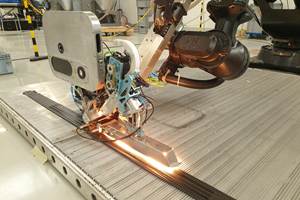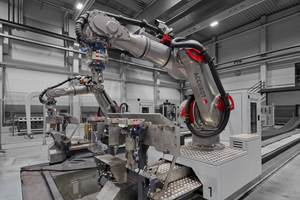Innovation: Moving faster than ever
The rate of composites innovation is higher than I’ve ever seen, and the implications are significant.
“Everything that can be invented has been invented.” This line, famously but falsely attributed in 1899 to Charles Duell, commissioner of the US Patent Office, as part of a recommendation to shut down the Patent Office, nonetheless points to some common present-day assumptions that certain technologies have gone as far as they can go. Moore’s Law in semiconductors, for example, which, while slowing, may not yet be fully dead. Or the common trope that “automakers have taken powertrain technology as far as they can, so now they have to rely on lightweight composites to improve fuel efficiency.” Inevitably, within days, an announcement comes out disproving the notion, as an OEM unveils a new transmission with more speeds, or cylinder deactivation, or an improved hybrid vehicle. I’ve seen that movie too many times over the years.
In 1970, Alvin Toffler’s Future Shock popularized the feeling people have when “too much change occurs in too short a period of time.” But looking back, 1970 seems quite placid compared to today’s world. By some estimates, we generated more data during the past two years than has been created in the entire history of the human race up to two years ago. By 2020, an estimated 50 billion smart connected devices will populate the planet. Big Data, the Internet of Things and Industry 4.0 are all hurtling us toward ever greater “information overload.” Much of this is being enabled by continuing advances in computational speed (thanks to Moore’s Law) and technology that increasingly puts information quite literally at our fingertips (or eyes, ears and brains). We’re barely comfortable using a new technological marvel or handheld device only to find it quickly replaced by something even smarter, faster and cheaper.
We’ve become used to this in the electronics industry. But what about the composites industry? Is it experiencing an electronics-like acceleration in technological development? I believe it is. From my perspective, the rate of composites innovation today is higher than I have ever seen, and the implications are significant.
One implication is that the innovation locus is changing. From the 1970s to the 1990s, it was the aerospace and defense industries taking the lead in advanced composites. But recent history indicates some resistance to change: The Boeing 777X and F-35, for example, are built predominantly with fibers and resin systems developed in the 1980s. It’s pretty clear that the industrial market has taken the lead in disrupting the status quo.
That brings us to the second implication: Now, more than ever, it is difficult to define the state of the art for many aspects of composites technology. As soon as you think you know who is leading, someone comes up with a better — faster, cheaper, stronger (you pick which adjective) — way to achieve the same goal. Take high-pressure resin transfer molding (HP-RTM), for example. Ten years ago, 10-15 minutes was considered fairly fast for parts the size of an automotive roof panel. Three years ago, this dropped to five minutes, and today’s resin formulations are able to cure in under two minutes, assuming we can get them into the mold fast enough. In fact, BMW is making many carbon fiber/ epoxy parts for their vehicles in two minutes using “wet pressing,” a highly automated version of what used to be a low-tech “mix and pour” process. Who needs HP-RTM when you can simply do this?
Other areas of innovation abound. Novel low-cost and low-energy precursors for carbon fiber, rapid and low-waste preforming technologies, and thermoplastic overmolding of structural inserts are also moving forward with abandon. And although it’s become ingrained that we cannot accurately predict crash behavior of composites, I’ve seen plenty of recent demonstrations that we can, indeed, do so.
Then there’s polymer 3D printing. It’s gone from shoebox size to full cars and large tools in the short span of three years (a recently printed tool for Boeing was certified to be a record in terms of dimension — certain to be superseded in 2017, if not before). There are efforts to do the same in metallic 3D printing, which will transform the tooling industry.
And just a few years ago, there were only a handful of companies with promising technologies for recycling carbon fiber composites. Today, there are dozens, and the long-term survival of each of these service providers will depend on its ability to create a compelling value proposition beyond landfill avoidance.
As part costs come down and the market grows, there will be room for many materials and many processes. However, that brings up a third implication: This new landscape makes managers’ jobs even tougher — what investments do we make in capital and R&D that won’t be obsolete in two years? There are no easy answers to this question, but it sure feels great to be aboard this fast-moving train!
Related Content
Aurora reveals latest SPRINT X-Plane design concept
An Aurora and Boeing team advances its high-speed, vertical lift concept to the preliminary design phase, which features three lift fans, a more refined composite exterior and an uncrewed cockpit.
Read MoreComposite sidewall cover expands options for fire-safe rail components
R&D project by CG Rail explores use of carbon fiber-reinforced thermoplastics and recycled manufacturing scrap to meet fire safety, weight and volume targets.
Read MoreATLAM combines composite tape laying, large-scale thermoplastic 3D printing in one printhead
CEAD, GKN Aerospace Deutschland and TU Munich enable additive manufacturing of large composite tools and parts with low CTE and high mechanical properties.
Read MoreAutomated robotic NDT enhances capabilities for composites
Kineco Kaman Composites India uses a bespoke Fill Accubot ultrasonic testing system to boost inspection efficiency and productivity.
Read MoreRead Next
VIDEO: High-volume processing for fiberglass components
Cannon Ergos, a company specializing in high-ton presses and equipment for composites fabrication and plastics processing, displayed automotive and industrial components at CAMX 2024.
Read MoreAll-recycled, needle-punched nonwoven CFRP slashes carbon footprint of Formula 2 seat
Dallara and Tenowo collaborate to produce a race-ready Formula 2 seat using recycled carbon fiber, reducing CO2 emissions by 97.5% compared to virgin materials.
Read More“Structured air” TPS safeguards composite structures
Powered by an 85% air/15% pure polyimide aerogel, Blueshift’s novel material system protects structures during transient thermal events from -200°C to beyond 2400°C for rockets, battery boxes and more.
Read More






.jpg;maxWidth=300;quality=90)










